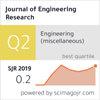Regeneration and mass transfer simulation for remazol brilliant violet dye adsorption by pineapple peel–based adsorbent
IF 0.9
4区 工程技术
Q3 ENGINEERING, MULTIDISCIPLINARY
引用次数: 0
Abstract
The successful preparation of pineapple peel activated carbon (PineAC) using a low–cost and environmentally friendly method presented a promising alternative for the utilization of pineapple peel (PineP) waste. The remarkable regeneration capability of PineAC significantly enhances its possible reusable adsorbent for the effective Remazol Brilliant Violet 5 R (RBV 5 R) dye adsorption. The Polymath software was employed to gain deeper insights into the mass transfer process and optimize the adsorption kinetics. PineAC's performance was investigated using characterization techniques such as surface analyzer, Energy Dispersive X–ray (EDX), Fourier Transform Infrared (FTIR) spectroscopy, and X–Ray Diffraction (XRD) analysis. The optimal conditions for the adsorption of PineAC–RBV 5 R dye were at 60°C, in an acidic medium, and at 300 mg/L. The Langmuir isotherm model successfully described the monolayer behaviour of RBV 5 R dye adsorption onto PineAC at 30 and 45°C. In contrast, the Freundlich isotherm model was applicable at 60°C. The PineAC–RBV 5 R dye exhibited a maximum adsorption capacity (qmax) of 66.300 mg/g. The kinetic data demonstrated excellent agreement with the Polymath Mass Transfer (PMT) model, successfully capturing adsorption behavior. The rate constant, kPTM, displayed an increasing trend as the RBV 5 R initial concentration rose from 25 mg/L to 300 mg/L. Furthermore, the PMT model accurately predicted the adsorption surface area, aPMT, to be 466.6560 m2/g, closely matching the actual mesopores surface area of 547.8500 m2/g. This remarkable accuracy highlights the reliability and robustness of the PMT model in describing the adsorption process. PineAC–RBV 5 R dye adsorption exhibited consistent thermodynamic behaviour characterized by endothermic adsorption (ΔH°=28.49 kJ/mol), a physisorption mechanism (Ea=24.02 kJ/mol), and spontaneity (ΔG°=10.74 kJ/mol). The potential mechanisms involved in the PineAC–RBV 5 R dye adsorption included n–π interactions, hydrogen bonding, and π–π interactions. The regeneration effectiveness of PineAC–RBV 5 R dye adsorption was 72.30% for the third cycle without causing any surface morphological alterations in agreement with SEM images and EDX spectra. Investigating the adsorption mechanisms and the potential for further functionalization of PineAC could provide opportunities for enhanced performance and expanded applications in sustainable wastewater treatment.
菠萝皮吸附剂吸附雷马唑亮紫染料的再生和传质模拟
低成本、环保的法制备凤梨皮活性炭(PineAC)为凤梨皮废弃物的资源化利用提供了新的途径。PineAC显著的再生能力显著提高了其可重复使用吸附剂对Remazol Brilliant Violet 5 R (RBV 5 R)染料的有效吸附。采用Polymath软件对传质过程进行深入分析,并优化吸附动力学。利用表征技术,如表面分析仪、能量色散x射线(EDX)、傅里叶变换红外(FTIR)光谱和x射线衍射(XRD)分析,研究了PineAC的性能。对pineac - rbv5 R染料的最佳吸附条件为:60℃,酸性介质,300 mg/L。Langmuir等温模型成功地描述了30和45℃下rbv5 R染料在PineAC上的单层吸附行为。Freundlich等温线模型在60℃时适用。pineac - rbv5 R染料的最大吸附量(qmax)为66.300 mg/g。动力学数据与Polymath传质(PMT)模型非常吻合,成功地捕获了吸附行为。随着rbv5 R初始浓度从25 mg/L增加到300 mg/L,速率常数kPTM呈增加趋势。此外,PMT模型准确预测吸附表面积aPMT为466.6560 m2/g,与实际介孔表面积547.8500 m2/g非常吻合。这种显著的准确性突出了PMT模型在描述吸附过程中的可靠性和鲁棒性。PineAC-RBV 5 R染料吸附表现为吸热吸附(ΔH°=28.49 kJ/mol)、物理吸附(Ea=24.02 kJ/mol)和自发吸附(ΔG°=10.74 kJ/mol)。参与PineAC-RBV 5 R染料吸附的潜在机制包括n -π相互作用、氢键和π -π相互作用。扫描电镜和EDX光谱显示,第三次循环时,PineAC-RBV 5 R染料吸附的再生效率为72.30%。研究松果酸的吸附机理和进一步功能化的潜力可以为提高其性能和扩大其在可持续废水处理中的应用提供机会。
本文章由计算机程序翻译,如有差异,请以英文原文为准。
求助全文
约1分钟内获得全文
求助全文
来源期刊

Journal of Engineering Research
ENGINEERING, MULTIDISCIPLINARY-
CiteScore
1.60
自引率
10.00%
发文量
181
审稿时长
20 weeks
期刊介绍:
Journal of Engineering Research (JER) is a international, peer reviewed journal which publishes full length original research papers, reviews, case studies related to all areas of Engineering such as: Civil, Mechanical, Industrial, Electrical, Computer, Chemical, Petroleum, Aerospace, Architectural, Biomedical, Coastal, Environmental, Marine & Ocean, Metallurgical & Materials, software, Surveying, Systems and Manufacturing Engineering. In particular, JER focuses on innovative approaches and methods that contribute to solving the environmental and manufacturing problems, which exist primarily in the Arabian Gulf region and the Middle East countries. Kuwait University used to publish the Journal "Kuwait Journal of Science and Engineering" (ISSN: 1024-8684), which included Science and Engineering articles since 1974. In 2011 the decision was taken to split KJSE into two independent Journals - "Journal of Engineering Research "(JER) and "Kuwait Journal of Science" (KJS).
 求助内容:
求助内容: 应助结果提醒方式:
应助结果提醒方式:


